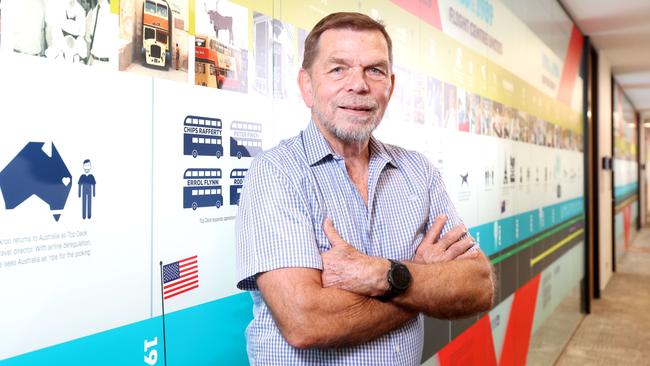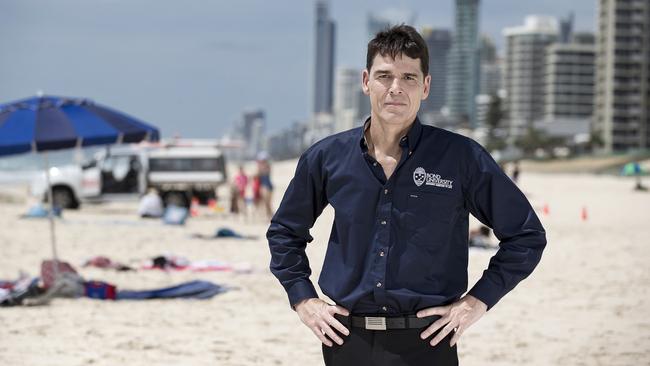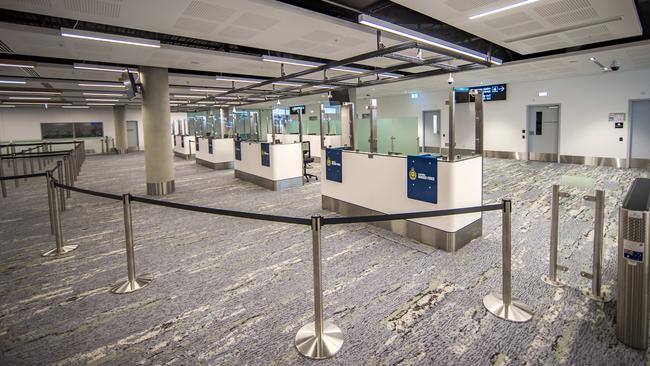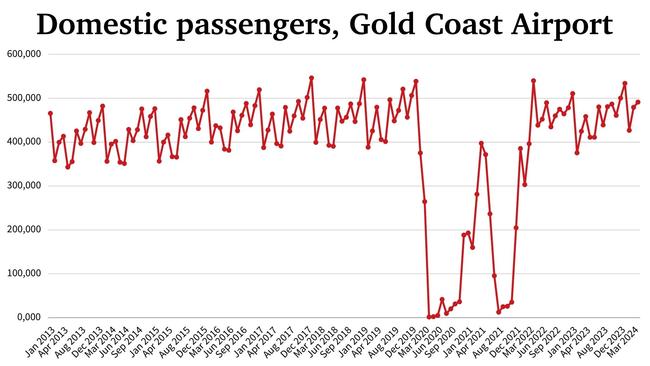Gold Coast Airport struggles for overseas routes despite $260 million terminal expansion
Little expense was spared in building a $260m expansion at Gold Coast Airport. But two years after it opened international routes have nosedived. This is what’s gone wrong.
Gold Coast
Don't miss out on the headlines from Gold Coast. Followed categories will be added to My News.
Just after 7am on 11 November 2022 more than 300 passengers stepped off a flight from Singapore and into the Gold Coast Airport’s new $260 million southern terminal.
Later that day the modern building, decked out with glass aerobridges, welcomed flights from Japan and New Zealand.
It marked the completion of a three-year project which had doubled the airport’s terminal footprint to cater for an expected surge in demand ahead of the 2032 Olympics.
At an official ribbon cutting ceremony that day, Senator Murray Watt said he was pleased the new terminal would “welcome even more visitors from all over the globe”.
Queensland Airports Limited CEO Amelia Evans said: “We are ready to welcome the world”.
There was talk among tourism figures of trying to secure routes from India and the Middle East.
However less than two years later, the aerobridges are little used.
A cafe, duty free store and a WHSmith outlet at the impressive new international departures lounge are operating on limited hours.
The towering windows of the new international arrivals hall – intended to give travellers a bright and airy welcome – instead just serve to showcase to passers-by how often the area lies dormant.
The services to Japan and Singapore celebrated on that official opening day have long since been discontinued. Direct flights to Kuala Lumpur and Seoul are also now a memory, leaving a Bali route as the airport’s only regular direct connection outside Australia and New Zealand. Airlines have pointed to weak demand for their decisions.
The impact is seen in data from the federal government’s Bureau of Infrastructure and Transport Research Economics (BITRE). In February this year the airport welcomed just 45,473 international passengers – excluding the Covid-19 period, its lowest number in any month since June 2011.
In April the airport had 56,721 international passengers, compared to April 2019 when 81,121 international passengers were recorded.
So what has gone wrong?

QUESTIONS OVER SUPPORT
In 2022 the Gold Coast won a share of the state government’s $200 million Attracting Aviation Investment Fund, designed to secure more direct international flights into Queensland, following a campaign by the Bulletin.
However it is unclear how many routes have resulted, beyond Air New Zealand’s expansion of its Auckland service.
Sources in council said they feared the “sidelining” of Gold Coast Airport figures from senior leadership positions in Experience Gold Coast – the city’s powerful tourism, events, education and arts entity – and a lack of dedicated funds in the city budget had “hamstrung” the airport, preventing it from securing its fair share of international flights.
Prior to Covid, the Gold Coast had overseas routes with New Zealand, Korea, Japan, Malaysia and Singapore, having also seen Chinese carriers exit years prior to Covid.
An experienced tourism figure said the city was struggling to return to its previous standing as a destination for direct flights.
“After Covid, Korea never restarted, Japan shifted its flights to Brisbane, Scoot withdrew from the market and both Air Asia and Kuala Lumpur are gone,” the figure said.
“It’s a fair conclusion to draw that, compared with what the Gold Coast used to have, our international presence is substantially less.
“The international recovery has proved very difficult because the focus for carriers has been the capital cities and the Gold Coast’s proximity to Brisbane has been an issue, but it also was prior to Covid.”
The airport is currently also going through a sale process.

Flight Centre CEO Graham Turner said he was confident the Gold Coast’s market would recover long-term but there would be pain for terminal retail operators in the short-to-medium term.
“It’s going to be a matter of time because we are still having an issue getting more flights in the major cities,” he said.
“Assuming there is no major panic, it will just take time but for the people trading in the terminal, it’s going to be really tough for them in the meantime.
“Brisbane is going to keep attracting the flights first and once this demand has been reasonably met, they will look at other airports.
“It’s only natural that it will happen for Brisbane first and the Gold Coast second but I have no doubt they will come back.”

Tourism and Transport Forum CEO Margy Osmond praised the airport’s infrastructure and said that while a short-term recovery was unlikely, she believed there would be a long-term recovery.
“It’s a great airport which has gone through its renovation process with all its new mod cons, New Zealand visitation is at pre-Covid levels, so the city’s biggest market has already recovered, but while I acknowledge there have been some losses and gains in terms of international travels, it is a similar story at other airports too,” she said
“It has been a bit up and down but the Gold Coast is not unique in this. In terms of getting more routes, the work of Tourism and Events Queensland and Experience Gold Coast will bear fruit, but you cannot turn it around on a dime, it will take time to see those results, so patience is a virtue.”
Ms Osmond said it would be “nice” to have more government funding support to help secure more routes, but insisted work was being done to lock in the return of airlines.

CAUGHT IN THE INDUSTRY’S HEADWINDS
In February, March and April this year – the last three months for which figures are available – 149,915 international travellers passed through Gold Coast Airport. The equivalent figure last year was 192,092.
Dr Michael Raybould, a tourism economist at Bond University, said the airport had likely fallen victim to a combination of problems facing the industry, including a shortage of planes and pilots.
“A lot of airlines have needed to retire older aircraft. Qantas for example retired the whole of their 747 fleet. At the same time Boeing’s supply chain problems means that Boeing are running very late in delivering new aircraft, so a lot of the airlines are currently hanging out for late deliveries,” he said.
“There’s also a shortage of pilots, because during Covid a lot of the airlines took the opportunity to either force or incentivise older pilots to retire. And pilots take some time to train.
“So there’s a shortage of planes and there’s a shortage of pilots. Those airlines are putting those resources on the routes that produce the highest yield.
“The Gold Coast Airport is a leisure market. We’re a price sensitive leisure market, as opposed to Sydney and Melbourne which tend to be more big city business conferences markets. Airlines can get a higher yield on the big cities.
“The fact is the airlines are going to continue allocating resources where they can get the best return.”

Dr Raybould said that compounding the issue, demand was weak among the Gold Coast’s traditional overseas markets.
“If you think about the major markets for the Gold Coast in recent years, the China market is currently struggling, they have low consumer confidence,” he said.
“Chinese real estate is devalued and their unemployment levels are high. They’re dealing with economic challenges they haven’t seen in 30 years.
“The other important market in the past for the Gold Coast has been Japan. And the Japanese yen has been at record low levels. It’s the worst exchange rate the Japanese have seen in 30 years plus. So we are a very expensive holiday for the Japanese.
“The other issue is New Zealand, which is going through the same kind of economic challenges that we are – the cost of living crisis and low consumer confidence.
“So there are a number of challenges with our major (international) markets.”

SILVER LINING IN THE CLOUD
On the upside for the airport, the number of domestic travellers passing through its doors reached a record high of 5.6 million in the last financial year.
Industry sources said one of the key factors holding back international travel – the growing cost of living that has sapped household budgets – had also helped the airport domestically, with Australians concerned by the cost of international travel choosing to holiday on the Gold Coast instead.
The airport also last week announced that Hong Kong Airlines would operate flights to the Asian metropolis to coincide with the Chinese Lunar New Year period in January and February next year.
Although the flights will only operate for five weeks, industry sources said it was a positive sign, with hopes that more routes could follow if demand proved strong.
However a Gold Coast Airport spokesperson admitted international passenger numbers remained about 30 per cent below what was seen before Covid disruptions.
“Domestic passenger numbers at Gold Coast Airport are exceeding pre-Covid levels, and international passenger numbers are sitting at around 30 per cent below pre-Covid figures,” the spokesperson said.
“Across Australia, total international passenger numbers are also still below pre-Covid levels.
“Last financial year, Gold Coast Airport facilitated more than 706,000 international travellers, an increase on the year prior.
“Globally, international travel is still in recovery mode, as airlines continue to face significant headwinds with fleet and crew constraints. This has led to the reprioritisation of some of Gold Coast Airport’s international routes to other Asian markets.”

The spokesperson said the airport’s $260 million investment in the terminal expansion was to support long-term passenger growth, with its Draft Master Plan forecasting 2.4 million international passengers a year to pass through the airport by 2044 – more than triple the current number.
The spokesperson said new facilities at the airport were not being left idle because they could be used by both domestic and international travellers.
“Gold Coast Airport’s single terminal building uses innovative swing functionality which means facilities are utilised by both international and domestic passengers,” they said.
“This flexible approach enhances operational efficiency and optimises the use of our infrastructure which enables Gold Coast Airport to keep its international airport charges much lower than other major airports.”
EFFORTS TO ATTRACT NEW BUSINESS
The Gold Coast Airport spokesperson said its Aviation Business Development team was “in constant communication” with airlines, “demonstrating the viability of new connections to the Gold Coast”.
Experience Gold Coast head of visitor economy and corporate relations Rachel Hancock said the council-funded body was also working to help bring new business to the airport.
“One of our key priorities is to grow connectivity and secure new airline partnerships so the Gold Coast can tap into new markets but also re-establish links with markets, like we have done with Hong Kong,” she said.
“The $200 million Attracting Aviation Investment Fund has been instrumental in developing new connection opportunities and Experience Gold Coast continues to work with the Queensland government and the City of Gold Coast to support both Gold Coast and Brisbane Airports in attracting airlines as part of post-pandemic recovery.”
Ms Hancock said that the loss of international connections to Gold Coast Airport “of course has an impact and is disappointing”, but she was confident numbers would grow.
“Aviation and international tourism continue to recover, and we anticipate strong demand which will attract new airlines and additional capacity to the Gold Coast,” she said.
She added that Experience Gold Coast teams had been busy promoting the city overseas.
“Experience Gold Coast’s international market development team, have over recent months, completed missions in key international growth markets including NZ, China, Japan, South Korea, USA and a market specialist is focused on business development in emerging markets including India, Indonesia, Philippines and South East Asia,” Ms Hancock said.
“We have a team currently in Hong Kong and China, supporting the new Hong Kong Airlines connection launch for example, and in Japan and South Korea promoting the Gold Coast at Tourism Australia marketplace, educating international tourism operators on the Gold Coast product and experiences.”
More Coverage
Originally published as Gold Coast Airport struggles for overseas routes despite $260 million terminal expansion




